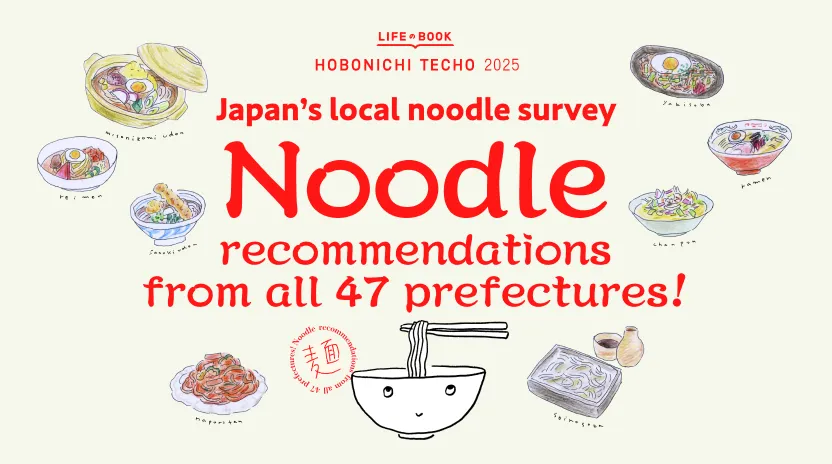Akita

Recommended noodles from the 47 prefectures
Akita Prefecture
We received a lot of comments about:
- Inaniwa Udon
- Yokote Yakisoba
Share
2024-11-06
Illustration: Aya Ishimatsu (Shimarisu Design Center)

Akita Prefecture
We received a lot of comments about:
2024-11-06
Illustration: Aya Ishimatsu (Shimarisu Design Center)
Inaniwa Udon
This is the udon I’ve enjoyed since I was a child. It has a nice chewiness, a smooth texture, and a beautiful appearance, with flat noodles that blend well with any broth. It’s delicious with a simple dipping sauce, curry, or anything, really. My favorite way is to make kake udon with it and add a can of nameko mushrooms and chrysanthemum sold in Akita—it’s simply delicious.
(Todo)
The king of noodles. The term “hand-stretched” is no exaggeration. At a factory in Inaniwa Town, Yuzawa City, you can even watch artisans hand-stretching the noodles. Yes, all the Inaniwa Udon you enjoy is hand-stretched. Its smooth texture and firmness make it a noodle the Tohoku region can be proud of. It even pairs well with Thai curry, transcending borders!
(Miruko)
“Sato Yosuke,” “Mugendo,” and “Kanbun Gonen-do” are famous longstanding shops, but all are delicious. The noodles are slender and lustrous, exuding a refined elegance—a slightly special udon. If you’ve never tried it, I highly recommend experiencing that smooth texture!
(Kizawa Mai)
You can enjoy it both warm and cold! The noodles are incredibly smooth and visually stunning. You can even buy end pieces to use as baby food, and it’s easy for the elderly to eat, too—it suits everyone and tastes great. I often make cold Inaniwa Udon with a sesame dipping sauce or warm Inaniwa Udon with grated daikon and nameko mushrooms.
(Menma)
“Kanbun Gonen-do’s” fresh Inaniwa Udon noodles. Usually, Inaniwa Udon is dried, but these fresh noodles are so chewy and satisfying. It’ll change your view of Inaniwa Udon.
(Yu)
No matter where you eat it, it’s delicious. Whether from a famous shop, a drive-in, or frozen noodles, it’s always outstanding.
(Kanazawa no kamaboko niwa ita ga nai)
I like to eat it with green curry.
(Chiimachi)
Yokote Yakisoba
A specialty of Yokote City, Akita Prefecture, it’s well-known from the B-1 Grand Prix and is one of Japan’s top three yakisoba varieties. Made with straight boiled noodles, cabbage, and ground pork, and flavored with a dashi-infused Worcestershire sauce, it’s topped with a fried egg and red pickled fukujinzuke. When you break the runny yolk and mix it with the noodles, it’s delicious! There are many great restaurants in the city known as the big four, but I highly recommend “Kuidoraku” that wins constantly!
(Patora)
It’s become quite famous as a B-grade gourmet dish from Yokote City, but to me, it’s a taste of childhood, a flavor I enjoyed at my mother’s family’s home in Yokote. Until I grew up, I thought “Yokote Yakisoba” was the standard yakisoba. While regular yakisoba uses steamed noodles, this one uses boiled noodles. It’s made with ground pork and cabbage, topped with a fried egg with runny yolk and red fukujinzuke. Even now, I occasionally crave it.
(Ashisaga)
When it comes to B-grade gourmet, it’s a must-try. With a fried egg on top, it’s delicious!
(Akita no Tama chan)
Nishimonai Soba
This famous soba is eaten throughout the Nishimonai area in Ugo Town, in southern Akita Prefecture. The noodles are made with funori seaweed as a binding agent, giving it a unique flavor and firmness. It’s usually enjoyed with cold broth, known as “hiya-gake,” which makes it easy to slurp. While there are many delicious shops in each town, my top recommendation is “Hikosa.” The soba is, of course, delicious, and the crispy kakiage with giant crown daisy, small shrimp, and soba grains is also outstanding!
(Arisu)
This is soba you can enjoy in Ugo Town, home of the Nishimonai Bon Dance, a UNESCO Intangible Cultural Heritage. It’s firm and chewy noodles served with cold broth, and it’s a dish I find myself craving sometimes. I recommend the original “Yasuke Soba” and “Shinta Soba.”
(Hiikorori)
Noshiro Udon
Most people think of Inaniwa Udon when they think of Akita, but for kiritanpo hot pot, “Noshiro Udon” is a perfect match. These are thin dried noodles, which are boiled, chilled in cold water, then loosened into the warm kiritanpo soup—delicious! Since the noodles cook from residual heat, it’s crucial not to leave them in for too long. At my family’s house, the rule was “overcooked udon isn’t udon,” so after a ten-second count, everyone would quickly scoop out their noodles.
(Piisuman)
Jumonji Chuka Soba
A ramen from Jumonji Town in Yokote City, southern Akita Prefecture, featuring thin, curly noodles in a light dried sardine-based broth, topped with a unique addition—wheat gluten. It’s said you can’t achieve this taste without high-quality water, so you’ll rarely find it outside Akita. Locals have loved it as a light meal or snack for generations.
(Kirishitan)
Akita
Inaniwa Udon